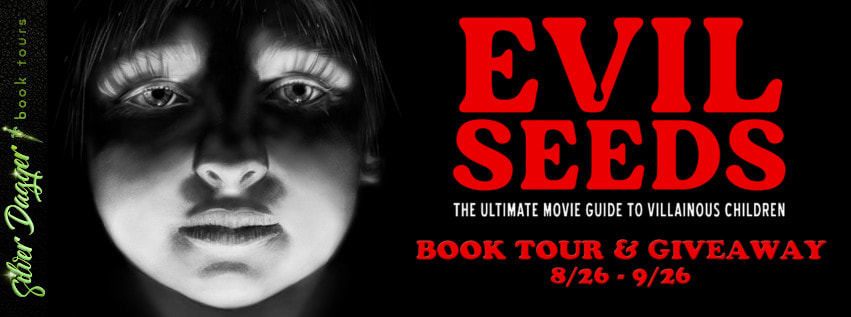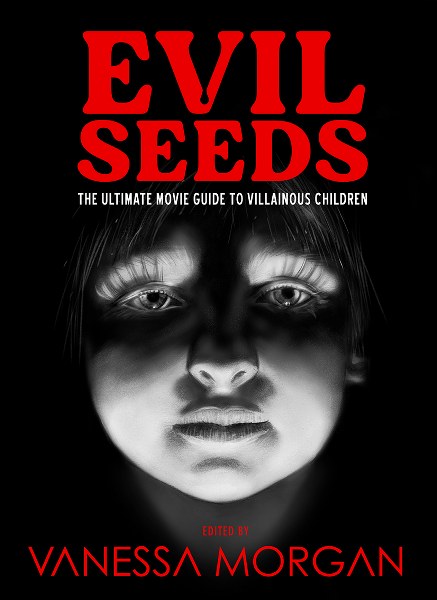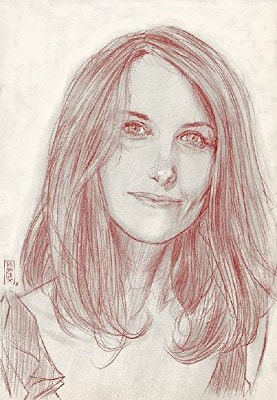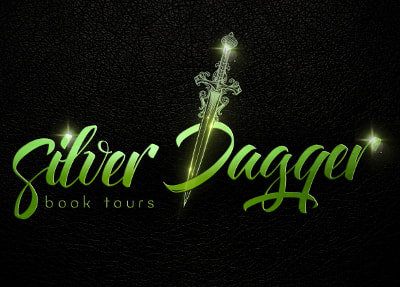Evil Seeds: The Ultimate Movie Guide to Villainous Children by Vanessa Morgan ➱ Book Tour with Giveaway
Evil Seeds:
The Ultimate Movie Guide to Villainous Children
by Vanessa Morgan
Genre: Thriller, Horror, Drama, Movie Reference Guide
Something's wrong with the children. They're murdering classmates, torturing parents, speaking in tongues, drinking human blood, and practicing black magic. Your offspring is on the rise, their blood no longer innocent. There will be casualties, and you may be among them.
Featuring nearly 250 of the creepiest, weirdest, and most dangerous kids ever to inhabit the cinematic landscape and sourced from over 40 different countries, Evil Seeds is THE comprehensive movie guide to villainous children in all their incarnations: the supernatural horror of ghosts and demonic possession, twisted tales of twins and changelings, dark matters of witches and evil babies, visceral frights of werewolves and vampires, the lurid lore of golems and trolls, and shocking drama of murderous orphans, juvenile serial killers, survivalist youngsters, and disturbing family values.
From cult classics to obscure fan favorites, Evil Seeds proves there is no shortage of frightening children. So keep an eye on your little darlings, or they might just fix their sights on YOU.
EVIL SEEDS EXCERPT #1 – MOVIE REVIEW: THE GOOD SON (1993)
By Justin Coote
In 1987, Ian McEwan's novel A Child In Time was being reviewed as a masterpiece, winning the prestigious Whitbread Novel Award. Soon after this success, 20th Century Fox contacted McEwan, also known as Ian Macabre due to his gothic short stories, to create a film that would affect moviegoers the same way his novels had affected readers. They gave him the vague task of writing a film "about evil – possibly concerning children." The result was The Good Son, the story of a young boy named Mark who, after his mother has passed away, is sent to live with his aunt and uncle for a few weeks while his father is away on business. He becomes close friends with his cousin Henry, who slowly starts to show signs of violent behavior.
Although the screenplay was well-received, it was not deemed commercial enough. It floated around in Hollywood limbo, going from 20th century Fox to Universal, where it was dropped after they were unable to secure funding. McEwan's story changed hands and studios for over three years, finally landing at Universal again, where Brian Gilbert (Voyage of The Damned, The Gathering) was set to direct. The film, once again, could not get proper funding and the production was canceled.
The success of The Silence of the Lambs (1991) proved there was money to be made from dark and intellectual thrillers, so now, the studios had the audience they needed to greenlight The Good Son. McEwan was excited that his "small but classy" story was finally going to make it to the big screen. That excitement was short-lived once child star Macaulay Culkin's father became interested in the project and demanded not only that his son be cast in the starring role but that his daughter Quinn have a part as well. His demands were followed up with threats that his son would not participate in the sequel to the blockbuster holiday hit Home Alone (1990) unless he was given the part. Because of the financial success of Home Alone and Culkin's star power, the studio agreed and production began.
It didn't take long for McEwan to be removed from the project. Nevertheless, the studio stayed true to the controversial ending and darker elements written before his departure. The final product is an experience in the existence of evil through someone who is typically thought of as innocent, simply because of their age. We're not asked to explore Henry's upbringing or family lineage to explain his actions. We're challenged to accept that harming others for our own gain comes naturally to some, even children.
The Good Son was released on September 6, 1993. Audiences were warned that Culkin would not be the sweetheart they had embraced in other films, and taglines like "evil can be as close as those you love" and "evil wears many faces" were on every poster next to the cold stare of America's favorite child star.
The film did well during its opening weekend but caused controversy due to a scene in which Culkin's character throws a dummy over a busy overpass and into oncoming traffic. Officials believed that this prank would inspire children to imitate the scene. Although there were reports of this happening, no actual reenactments are known to have taken place. The scene was removed from the UK video release, where The Good Son was never given a wide release anyway due to the murder of James Bulger, a toddler who was killed that same year by two 10-year-old boys. The distributors felt that releasing a popular film depicting a young killer would not only be disrespectful but also a sad reminder of the evil that naturally exists in the world.
EVIL SEEDS EXCERPT #2 – MOVIE REVIEW: OUIJA: ORIGIN OF EVIL (2016)
By Gert Verbeeck
Exorcisms deal with possession. Ouija boards conjure the spirits of the deceased. Haunted houses are inhabited by ghosts. We know the drill; we've seen this before. Yet here we have an outing that allows for surprise, blending some of these aspects into a cohesive film that serves as an origin story to Ouija (2014), which had a present-day setting. Linking the two films is a mere matter of winks – like the house of Debbie, a character from the 2014 film, featured in some exterior shots, and the epilogue scene, involving the Paulina Zander character, included as a closing credits easter egg.
With Origin of Evil best viewed as a stand-alone prequel, you won't find any teens messing around with the board this time (apart from one Ouija throwback scene). We care about the central characters, a single mother with two daughters in a suburban community during the 1960s. Back then, social standards didn't consider this "the norm" as an acceptable family situation. Bringing this awareness into the story helps in portraying a likable family-of-three. By the time things turn evil, we have all the emotional investment needed for wanting to see them survive.
Director Mike Flanagan and co-writer Jeff Howard went for a subtle, well-balanced approach, carefully dialing their supernatural amplifier up a notch as things progress. Alice Zander (Elizabeth Reaser) and her daughters Lina (Annalise Basso) and Doris (Lulu Wilson) are introduced running their private seance business at home. It's a clever scam to provide solace and consolation for their credulous clients. When teenage Lina suggests that her mum upgrade their act with a ouija game board, it's little Doris who first becomes aware of a new presence in the house. And with innocence gone, possession takes over.
The whole film is constructed with care for detail. Set design and props recreate a realistic period environment, while cinematography, sound, and editing enhance authenticity. When the tone gradually shifts toward a brooding atmosphere, it's one that prefers to creep up on you and downplays the jump scares. Ghostly manifestations do rely on CGI but are handled well by keeping most scenes darkly lit (and featuring Doug Jones on set in black ghoul costume). The first spectral appearances are of a more delicate kind, offering brief visual glimpses without explicit sound effects. It's a crafty way of building tension, evoking a sense of anxiety, slowly affecting our characters, as it rubs off, feels real, and gets under your skin. Before darker matters burst onto the screen, that is.
But the real driving force is the strong performances of our leading ladies. They portray characters with depth, and the family dynamic makes sense, even covering their perspectives on having to deal with the recent loss of the father/husband. Reaser and Basso portray a believable mother-daughter relationship that has its own narrative arc, and Wilson, as youngest daughter/sister Doris, impresses in every scene – from her line deliveries to her physical acting, from her sweetest moments to her incarnation of evil. Henry Thomas completes the main cast as Father Tom, a priest/dean with inner conflicts about the past, soon to discover a new dimension of what it means to be beyond deliverance.
Blumhouse Productions did well with Ouija: Origin of Evil, which surpasses the previous film, offering much more to appreciate. Thanks to Flanagan receiving considerable leeway, we spend enough time with the characters before he opens up the anticipated bag of spooky goodies. The fully orchestrated score, complete with strings and piano, also adds some classy magic to the proceedings, while filming primarily on Universal's backlot provided the luxury of shooting additional/extended scenes (which are worth seeing on the DVD and Blu-ray extras). Look for plentiful, well-disguised homages to and inspiration from classic cinema, ranging from Friedkin's The Exorcist (1973) to Hitchcock's Rear Window (1954). But the singularly most striking reason to recommend the film goes by the name of... Lulu Wilson.
THE WATCHER IN THE WOODS (1980) – MOVIE REVIEW BY EVIL SEEDS CONTRIBUTOR DOUG LAMOREUX
Director: John Hough
Cast: Bette Davis, Lynn-Holly Johnson, Kyle Richards, Caroll Baker
Country: USA
Two children are being haunted by something in the woods.
When producer Tom Leetch pitched the project to Walt Disney’s Ron Miller, he exclaimed, “This could be our Exorcist!” Then-ambitious, with the dark PG-rated The Black Hole under his belt, Miller couldn’t resist. Well, it isn’t The Exorcist. But just what is The Watcher in the Woods?
It’s the story of the Curtis family, Americans come to live on an isolated English estate owned by a reclusive, witch-like Mrs. Aylwood (Bette Davis; The Nanny). The Curtis daughters soon find they’re being haunted by something in the woods; teen Jan (Lynn-Holly Johnson; For Your Eyes Only) sees, young Ellie (Kyle Richards; Halloween) hears, a being from beyond. Whispers and broken mirrors abound. Mother (Carroll Baker; Paranoia) and father (David McCallum; She Waits) are bewildered. The locals are terrified. As the fear mounts, we learn the distraught Mrs. Aylwood, not a witch at all, is desperate for answers to a 30-year-old mystery.
Director John Hough had a solid horror pedigree; Twins of Evil, The Legend of Hell House, and (for Disney) both Escape to… and Return from Witch Mountain. Hough loved Brian Clemens’ (Dr. Jekyll and Sister Hyde) screenplay, based on Florence Engel Randall’s novel A Watcher in the Woods. But Disney, fearing it too dark, hired Rosemary Anne Sisson (Upstairs, Downstairs) to lighten the story. Harry Spalding (Curse of the Fly), and (uncredited) Gerry Day (The Black Hole) also had a go at the script. From their combined effort, Hough, and lighting cameraman Alan Hume and composer Stanley Myers, created a moody and stylish – but flawed – film.
To discuss The Watcher in the Woods is to discuss its troubling climax. A 100-minute preview, owing to its abrupt ending, tested poorly. Hough re-cut the ending (and the film to 84 minutes) and Disney released that version in April 1980. Critics and audiences savaged the new ending so badly that, within a month, Disney pulled the film from theaters. With a disaster on their hands, a scheduled (Easter 1981) re-release of Mary Poppins was moved up to fill Watcher’s commitments. Meanwhile, Disney needed a new ending. A SAG strike delayed photography until November when, with Hough unavailable, an (uncredited) Vincent McEveety (Star Trek) was brought in to direct. Special effects whiz Harrison Ellenshaw (Something Wicked This Way Comes) and an army of artists were hired – at a tremendous expense – to shoot a less-frightening pre-title opening and a new ending. This third version opened on 9 October 1981 to lukewarm reviews and complaints about the film’s ending.
The fault, in truth, lies not with the filmmakers or Disney but with the source material. Randall, apparently unsure whether she was writing horror or science fiction, wrote both and succeeded with neither. It’s a spooky novel with a nothing ending. A 2017 remake for British television, starring Anjelica Huston as Mrs. Aylwood, suffers the same weakness. The Watcher in the Woods was NEVER going to be Disney’s Exorcist. It is – like many film horrors – a disappointing whole with plenty of creepy ‘evil kid’ moments that make it a pleasure to see all the same.
Doug Lamoreux
Vanessa Morgan is the editor of the movie reference guides When Animals Attack: The 70 Best Horror Movies with Killer Animals, Strange Blood: 71 Essays on Offbeat and Underrated Vampire Movies, and Evil Seeds: The Ultimate Movie Guide to Villainous Children. She also has had one cat book (Avalon) and four supernatural thrillers (Drowned Sorrow, The Strangers Outside, A Good Man, and Clowders) published. Three of her stories have been turned into movies. She has written for myriad Belgian magazines and newspapers and introduces movie screenings at several European film festivals. She is also a programmer for the Offscreen Film Festival in Belgium. When she's not working on her latest book, you can find her reading, watching movies, eating out, or photographing felines for her blog Traveling Cats.
Newsletter * Facebook * Twitter * Bookbub * Amazon * Goodreads
Follow the tour HERE for special content and a giveaway!
$25 Amazon









Comments
Post a Comment